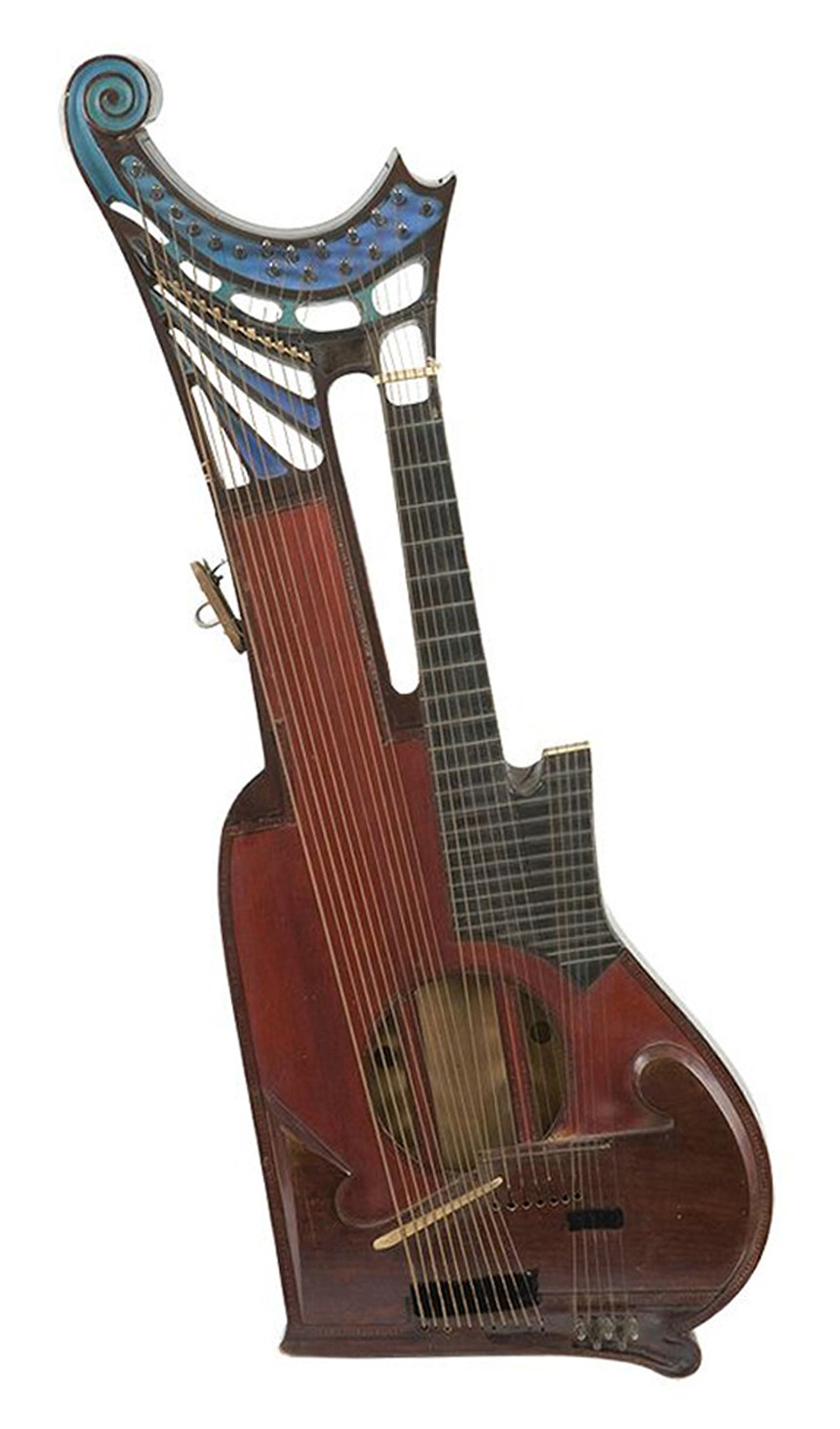 Alert readers likely spotted a small image of this instrument in my previous post on Russian harp guitars in Moscow’s Museum of Music. For my part, I’ve been after more on this unusual instrument ever since seeing the small curious image in my book of the collection some years ago.
Alert readers likely spotted a small image of this instrument in my previous post on Russian harp guitars in Moscow’s Museum of Music. For my part, I’ve been after more on this unusual instrument ever since seeing the small curious image in my book of the collection some years ago.
Then, last year, my Russian friend (and prolific submitter to Harpguitars.net) Ilya Kryzhanovsky located several sources on the instrument. Apparently, museum staff had been able to complete research on it and subsequently publicly display it in 2013.
While none of my contacts have been able to gain further access to the instrument for additional details and photographs, we have (just) enough info now to discuss this unusual instrument, largely thanks to translations of the web sources and images by my colleague Matthew Hill. It helps that Matthew is an expert on early electronic instruments (both American and Russian), having done his PhD on the subject.
For that’s what our mystery instrument is…or was…or was intended to be: a 1930s electric harp-zither-guitar!
Though today we must surely classify it as a form of “harp guitar” (with the museum author quoted below similarly describing it as a “hybrid instrument that combines the characteristics of guitar, harp and zither”) I would point out that here we truly have the least “harp-like” of harp guitars. Instead, it is a perfect example of a more-appropriately-named “zither guitar.” Let’s take a look:
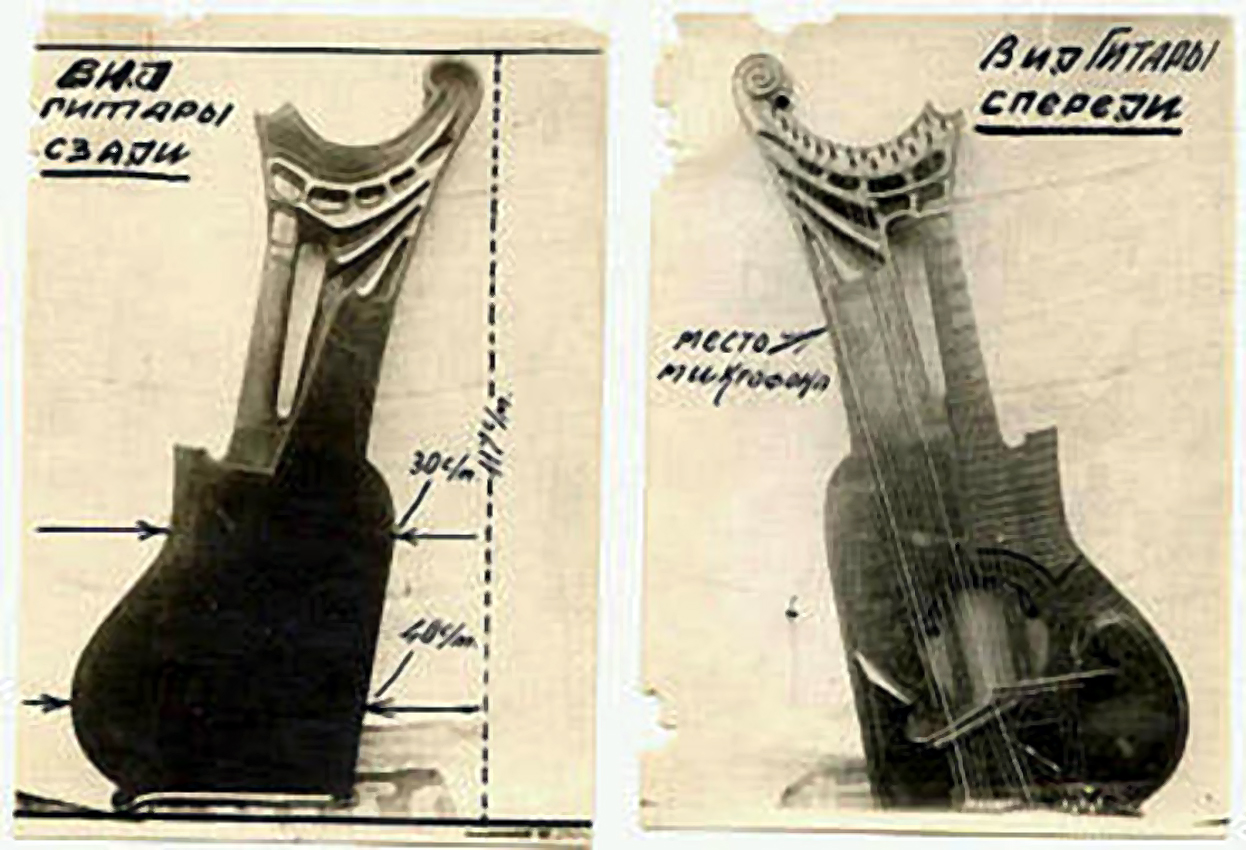
Above and further below I include the only other illustrations of it. They provide a few more details, including its size: 46” long (at the oblique angle shown) and 15.75” at its widest point. Why Shtryanin chose this odd shape is a complete mystery. Presumably, it wasn’t meant for display (in any position), but as a playing object. But held how? Like a guitar, as shown here:
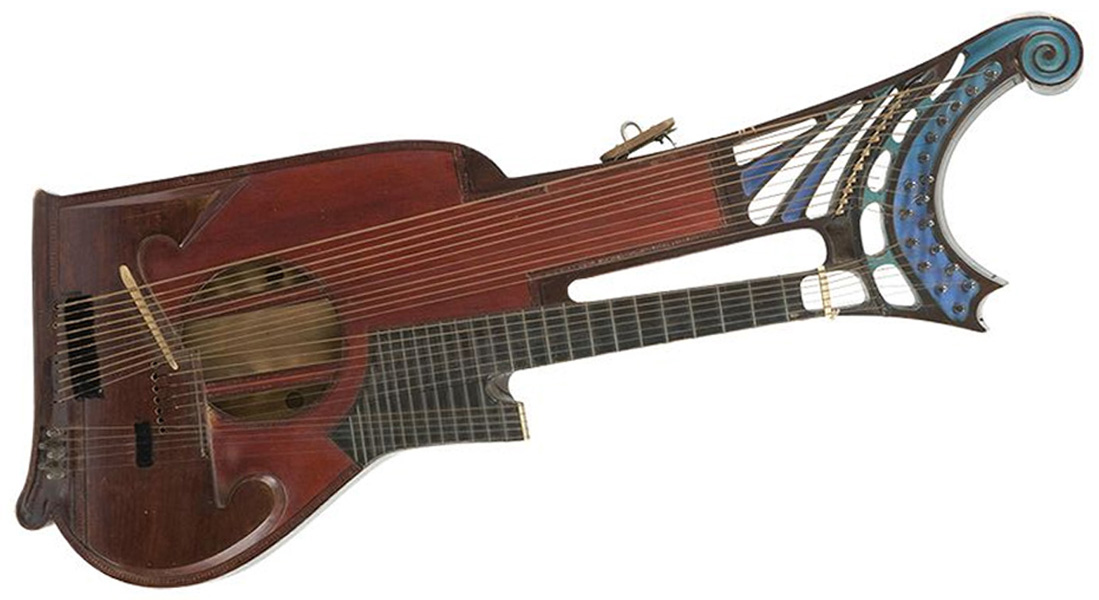
Or flat on the lap like a zither?
Indeed, though not described, the short neck is surely meant to be a standard 5-string zither soundboard, which could perhaps be played in guitar position – by someone intent on re-learning a complete new technique! Or was a Russian guitarist expected to fret his 7-string neck in lap position? Perhaps both playing positions were utilized as needed for each instrumental purpose, the open basses being employed for each choice. Presumably, the builder was familiar with both zithers and Russian harp guitars. My guess is that he may indeed have been thinking of the Russian harp guitar with its 3 or 4 open basses, but then extended that to a larger zither-like chromatic scale.
The entire head array, with its cut-outs and striking blue-painted decorative shapes, is distinctive, to say the least. Whether it is made of hardwood or cast in metal (or a blend) remains unanswered. The guitar neck’s nut – if that is indeed it, and not a separate string guide – seems to be defying gravity and tension as it straddles a large opening in the frame. Also, check out the “shared frets” of both fretboards (whether just a decorative illusion or not, pretty cool)!
Regarding the installation of the 23 strings, the guitar ends appear to slip into larger holes of seven string slots, while the 11 bass harp/zither strings may be threaded from the back or inside. The 5 zither strings are held and tuned via zither pins at the base, the other ends being pinned/held somehow behind and under an “end cap.”
It is not clear whether the separate carved string block is glued to the top soundboard. In the illustration below, this carved piece is referred to as “old (or previously existing?) soundboard.” Perhaps this is the piano soundboard remnant mentioned in the museum’s article, though I suspect that one is actually inside the instrument (shown in the middle of the box by the red dotted line in illustration). Numerous small holes appear to have been drilled in it within the area of the large outer soundhole. The two red-stained pillar braces clearly lie above this inner soundboard and look to be affixed to the (intentionally) thick top.
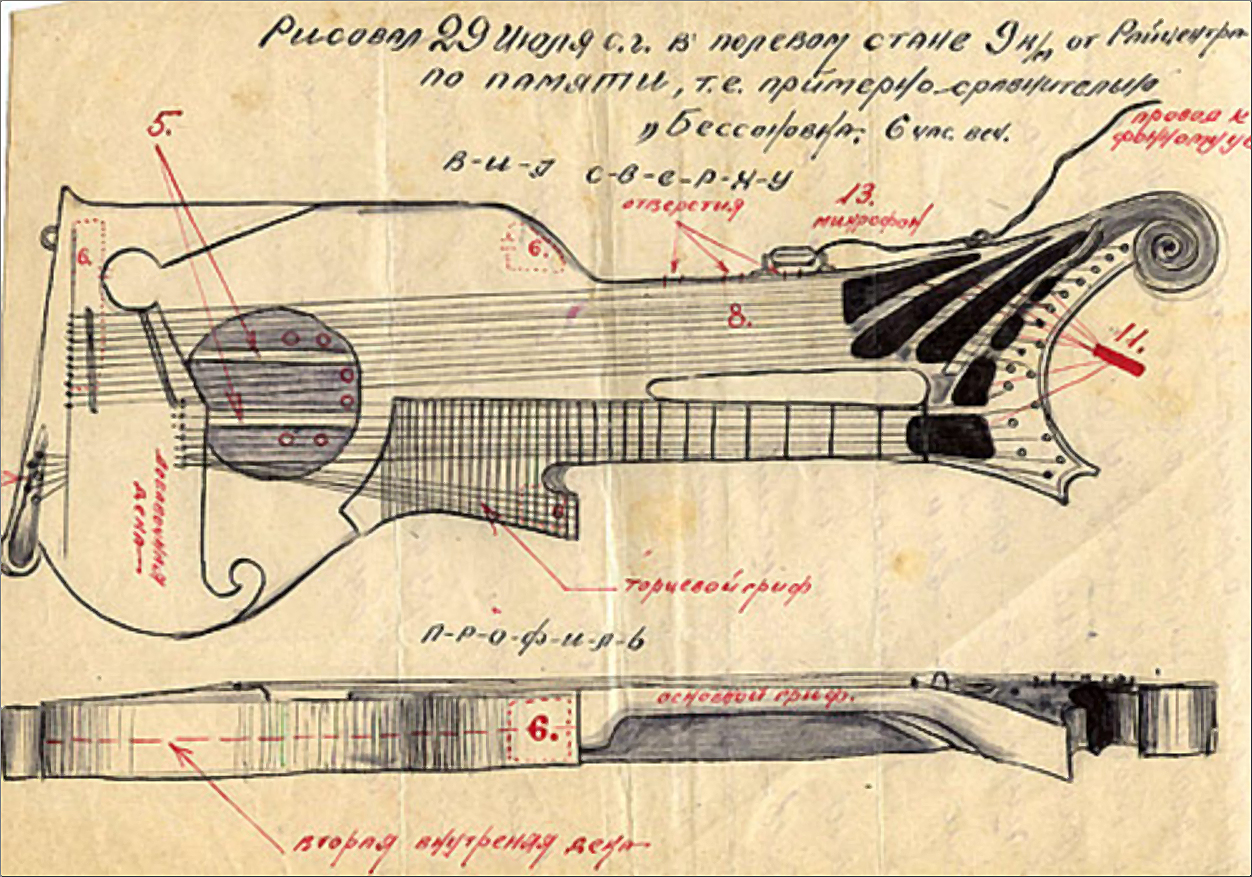
Finally, the little device hanging of the bass arm is the microphone pickup. Apparently, this was never tested, as the instrument – or at least its amplifying component – was never finished. The story of the inventor’s uncompleted plans for obtaining the funding and giving a successful performance on his c.1932-c.1934 instrument is told next by the Moscow museum (author not credited), translated by Matthew Hill (a few of his and my comments appear in parentheses). I find it extremely curious that the intent of Shtryanin seems to have been one of creating his country’s first electric guitar…so why the totally bizarre hybrid instrument? Neither the builder nor subsequent researchers seem to have an answer for that one!
Guitar-Zither of the Master Constructor Shtryanin
The (Glinka) Museum’s collection contains a strange-looking twenty-three-string guitar-zither made by luthier M. (Mikhail?) Shtryanin in 1934 in the village / hamlet of Bessonovka, Kuibyshev region.
The instrument came to the Museum from the All-Union House of Folk Art as part of a large collection – over 800 objects – of musical instruments of the peoples of the USSR after being exhibited at VDNKh (MH: this is a huge exhibition center in Moscow, built in the mid-1930s) in 1937. The collection that was received included both traditional instruments and reconstructed, improved, modernized and even experimental ones. Among the group of objects, the 23-string guitar remained a mystery for a long time, the body shape of which had a very bizarre appearance. There were too many “holes” in the “provenance” of this instrument, which is probably why this guitar was never exhibited in the Museum until 2013.
After the exhibition “Generation Z. The era of 1910-1930s” held in 2012 at the State Polytechnic Museum, the circumstances of the creation of M. Shtryanin’s guitar became clear: the exhibition published an article, “History of Party organizer Shtryanin and his 23-string guitar” (from the archive of the director of the “Theremencentre,” Andrey Smirnov).
Shtryanin’s guitar was created in the era of the first decades of Soviet power, an era of complex cataclysms that swept the spheres of politics, science and art. In an atmosphere of hunger, cold and poverty, creative people kept themselves alive with the ideals of a new country. It is no coincidence that in 1918, Anatoly Lunacharsky officially proclaimed that “creativity should be built on an experimental foundation.”
The guitar of M. Shtryanin in the Museum’s collection demonstrates an attempt to create an electric guitar-zither, one which was not brought to its logical conclusion. This experimental guitar was made as a one-of-a-kind instrument by an amateur luthier. It is a hybrid instrument that combines the characteristics of guitar, harp and zither. For the best sound, the maker made the body from an old piano soundboard.
This instrument was conceived by M. Shtryanin in 1932 as an electric guitar. Working in the difficult conditions of agricultural collectivization in the 1930s in one of the first collective farms “Gigant” in the village of Bessonovka, Kuibyshe region, the master did not have enough funds to purchase the planned adapter and electric amplifier. However, this was a bold attempt, independent of similar experiments in the United States. (GM: As MH noted to me, the author then gives some incorrect dates and inventions in the United States; I have omitted these to avoid further error dissemination.)
(M. Shtryanin’s invention) went unnoticed, misunderstood and did not receive the proper amplification (MH: I think they are making a pun here). To manufacture the pickup and amplifier, Shtryanin had to purchase some parts. However, by 1935, his wife’s patience began to run out, as her husband’s hobby required too much money from the family budget. For more than two years, the inventor has been in active correspondence with officials of all levels with a petition for financial support in the amount of 500 rubles (MH: At that time this was the approximate cost of a radio receiver), the last chance was a request through the Izvestia newspaper to the director of the State Institute of Musical Science Nikolai Alexandrovich Garbuzov with a request to provide information on the fate of the invention. The goal of the maker was not only to complete a new type of electric guitar, but also to play a concert on it in the village club. No material support was provided to the master. And this is probably why the guitar did not get the final look of an electric instrument. Nevertheless, Shtryanin did play a concert on the unfinished guitar in a village club in 1936, as reported in his last indignant letter.
In April 2013, the 23-string guitar-zither of master-designer M. Shtryanin was exhibited for the first time in the Museum at the exhibition “Exhibits in Focus”.
GM: So, there you have it: the up-to-date-insofar-as-we-can-decipher-it-here-in-the-States tale of M. Shtryanin’s Harp-Zither-Guitar! I’m hoping that one day Matthew (or one of you?) can go visit the museum in Moscow again to provide us with more details, as this one is rather unique!
And if you want to learn more about early Russian electronic instruments, see Matthew Hill’s article “Soviet Synthesizers: From Russia with LFO” on Reverb News.

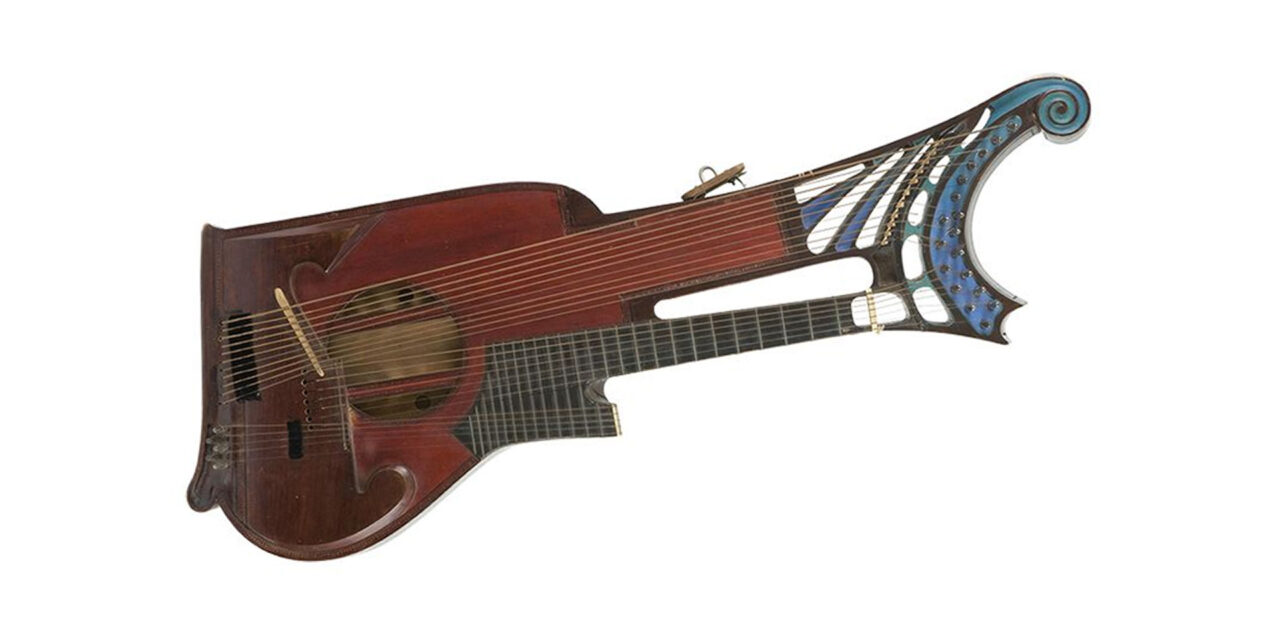
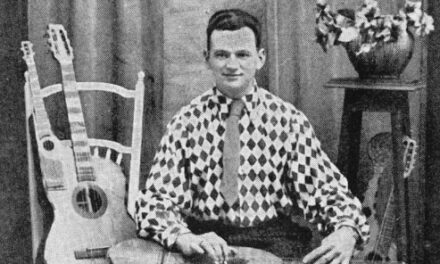
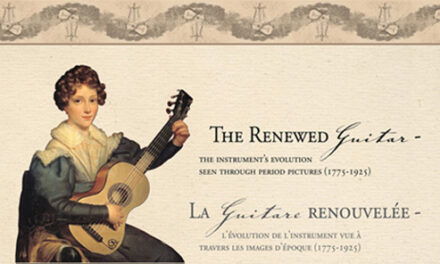
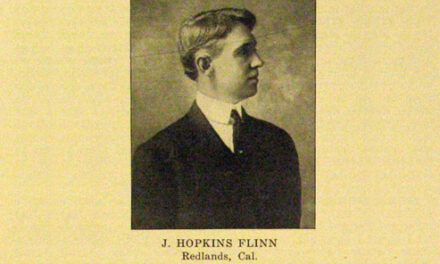
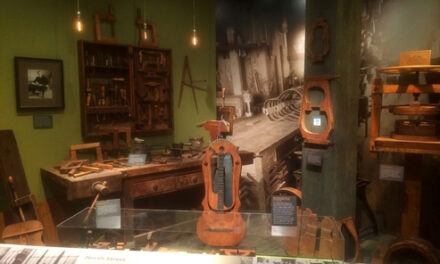
Interesting that the builder used a piano soundboard for the body. Steven Wishnevsky is still doing that!
Hi John. Many have. But I don’t think so in this case. As I state in my article, I think he used it for the inner soundboard.